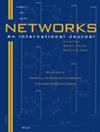具有不对称不确定性的最短路径网络拦截
IF 1.3
4区 计算机科学
Q4 COMPUTER SCIENCE, HARDWARE & ARCHITECTURE
引用次数: 0
摘要
本文探讨了最短路径网络阻截问题的扩展,其中包含了考虑参数不确定性的鲁棒性。最短路径拦截问题是一个由两个具有相互冲突的目的和能力的参与者组成的博弈:逃避者和拦截者,逃避者利用最短路径穿越从源节点到汇节点的网络弧线,而拦截者则通过拦截网络上的弧线使逃避者的最短路径长度最大化。通常假设定义网络的参数对双方来说都是完全已知的。我们考虑的情况是,规避者假设标称参数值,而拦截者使用鲁棒优化技术来考虑参数的不确定性或传感器的退化。我们将这一问题表述为非线性混合整数半无限双级程序,并证明它可以转换为带有二阶锥约束的混合整数线性程序。我们使用随机几何网络和交通网络进行计算研究,并展示了我们的变体所产生的独特决策策略。解决具有非对称不确定性的最短路径拦截问题可以保护拦截者,使其不必投资于依赖于关键拦截点是否如约执行的策略。它还提供了一种替代策略,可降低这些最坏情况可能性的风险。本文章由计算机程序翻译,如有差异,请以英文原文为准。
Shortest path network interdiction with asymmetric uncertainty
This paper considers an extension of the shortest path network interdiction problem that incorporates robustness to account for parameter uncertainty. The shortest path interdiction problem is a game of two players with conflicting agendas and capabilities: an evader, who traverses the arcs of a network from a source node to a sink node using a path of shortest length, and an interdictor, who maximizes the length of the evader's shortest path by interdicting arcs on the network. It is usually assumed that the parameters defining the network are known exactly by both players. We consider the situation where the evader assumes the nominal parameter values while the interdictor uses robust optimization techniques to account for parameter uncertainty or sensor degradation. We formulate this problem as a nonlinear mixed-integer semi-infinite bilevel program and show that it can be converted into a mixed-integer linear program with a second order cone constraint. We use random geometric networks and transportation networks to perform computational studies and demonstrate the unique decision strategies that our variant produces. Solving the shortest path interdiction problem with asymmetric uncertainty protects the interdictor from investing in a strategy that hinges on key interdictions performing as promised. It also provides an alternate strategy that mitigates the risk of these worst-case possibilities.
求助全文
通过发布文献求助,成功后即可免费获取论文全文。
去求助
来源期刊

Networks
工程技术-计算机:硬件
CiteScore
4.40
自引率
9.50%
发文量
46
审稿时长
12 months
期刊介绍:
Network problems are pervasive in our modern technological society, as witnessed by our reliance on physical networks that provide power, communication, and transportation. As well, a number of processes can be modeled using logical networks, as in the scheduling of interdependent tasks, the dating of archaeological artifacts, or the compilation of subroutines comprising a large computer program. Networks provide a common framework for posing and studying problems that often have wider applicability than their originating context.
The goal of this journal is to provide a central forum for the distribution of timely information about network problems, their design and mathematical analysis, as well as efficient algorithms for carrying out optimization on networks. The nonstandard modeling of diverse processes using networks and network concepts is also of interest. Consequently, the disciplines that are useful in studying networks are varied, including applied mathematics, operations research, computer science, discrete mathematics, and economics.
Networks publishes material on the analytic modeling of problems using networks, the mathematical analysis of network problems, the design of computationally efficient network algorithms, and innovative case studies of successful network applications. We do not typically publish works that fall in the realm of pure graph theory (without significant algorithmic and modeling contributions) or papers that deal with engineering aspects of network design. Since the audience for this journal is then necessarily broad, articles that impact multiple application areas or that creatively use new or existing methodologies are especially appropriate. We seek to publish original, well-written research papers that make a substantive contribution to the knowledge base. In addition, tutorial and survey articles are welcomed. All manuscripts are carefully refereed.
 求助内容:
求助内容: 应助结果提醒方式:
应助结果提醒方式:


